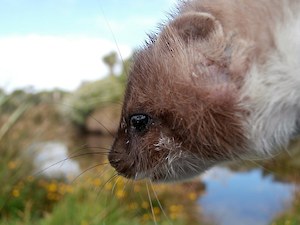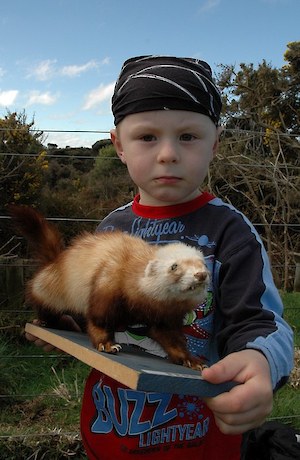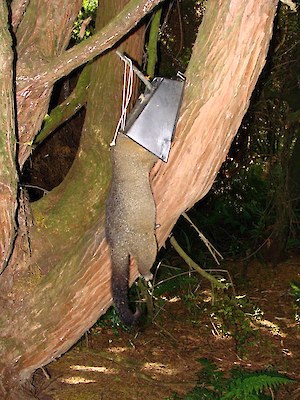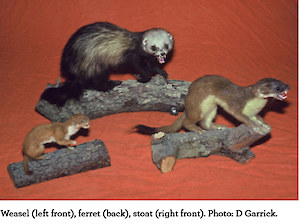Ship Rat
 Ship rats are the most frequent predator of small forest birds, seeds, invertebrates, and perhaps lizards in New Zealand forests, and are key ecosystem changers. Their varied diet also makes them competitors with native wildlife for food sources.
Ship rats are the most frequent predator of small forest birds, seeds, invertebrates, and perhaps lizards in New Zealand forests, and are key ecosystem changers. Their varied diet also makes them competitors with native wildlife for food sources.
The most common type of rat in Otatara is the Ship rat, also known as the Black rat, Roof rat and Bush rat. Ship rats are good climbers. They can be black or brown with creamy or slate grey undersides and they have big ears and long tails (always longer than the body). They are generally 120-160 grams in weight.
Norway Rat
 Norway rats are also present in Otatara but in much lower numbers. Norway rats are the bigger of the two species. They are not good climbers. They are brown or gingery brown in colour with pale undersides and their tails are shorter than their bodies. They are generally 170-270 grams in weight and can be as big as 350 grams. Norway rats are more fond of wet areas and drains than Ship rats. They are also better swimmers.
Norway rats are also present in Otatara but in much lower numbers. Norway rats are the bigger of the two species. They are not good climbers. They are brown or gingery brown in colour with pale undersides and their tails are shorter than their bodies. They are generally 170-270 grams in weight and can be as big as 350 grams. Norway rats are more fond of wet areas and drains than Ship rats. They are also better swimmers.
For further information check out www.pestdetective.org.nz/.
Possums
 A possum and a rat taking birds from a nestPossums browse on the leaves, flowers and fruit of native vegetation, especially rata, mistletoe, fuschia and kamahi, fruit trees and garden plants such as roses and silverbeet. They also eat eggs and young birds while they are still on the nest. If uncontrolled, possum densities can get quite high (up to 25/hectare and often 12/hectare) and they have a significant detrimental effect on the health, vitality and composition of the bush.
A possum and a rat taking birds from a nestPossums browse on the leaves, flowers and fruit of native vegetation, especially rata, mistletoe, fuschia and kamahi, fruit trees and garden plants such as roses and silverbeet. They also eat eggs and young birds while they are still on the nest. If uncontrolled, possum densities can get quite high (up to 25/hectare and often 12/hectare) and they have a significant detrimental effect on the health, vitality and composition of the bush.
Possums also occupy holes in tree trunks that would otherwise be used by nesting birds such as kakariki.
Possum control in Otatara over the last 10 years has significantly reduced possum numbers but there are still pockets of them around. Young males move around quite a bit seeking new territory.
Mice
 Like rats, mice will eat almost anything but mostly they feed on seeds and insects but they have been known to eat bird’s eggs and nestlings as well. They also eat insect and whitebait eggs. They have a much more significant effect on ecosystems than is immediately apparent.
Like rats, mice will eat almost anything but mostly they feed on seeds and insects but they have been known to eat bird’s eggs and nestlings as well. They also eat insect and whitebait eggs. They have a much more significant effect on ecosystems than is immediately apparent.
They are frequent invaders of homes and outbuildings, especially in Autumn and Winter and damage many things they come into contact with, either by urinating or defecating on it, eating it, chewing it, or a combination of all of these activities.
Mustelids

 A family of ferretsMustelids are a group of animals including stoats, ferrets and weasels. They are carnivores and only eat other animals. Stoats are the number one enemy of our native birds because they kill so many of them. Occasionally they attack domestic hens as well. Stoats and weasels are good climbers and swimmers and they hunt day and night. Being good climbers, they are a major threat to birds.
A family of ferretsMustelids are a group of animals including stoats, ferrets and weasels. They are carnivores and only eat other animals. Stoats are the number one enemy of our native birds because they kill so many of them. Occasionally they attack domestic hens as well. Stoats and weasels are good climbers and swimmers and they hunt day and night. Being good climbers, they are a major threat to birds.
Stoats, ferrets and weasels are all found in Otatara. Stoats and weasels tend to be more common near the margins of waterways. A considerable amount of stoat and weasel control has been undertaken over the last 10 years so fortunately, they are not common. However, there is still enough of them to wrought considerable damage.
Of late, ferrets seem to be the most common mustelid in Otatara with several having been trapped in the Autumn of 2019.
For further information on mustelids, check out www.pestdetective.org.nz/.
Rabbits
The Otatara Pestbusters don’t target rabbits, mainly because its objective is to protect birds, and rabbits don’t threaten birds. Having said that, it is recognised that rabbits are a significant pest in parts of Otatara. In a semi-rural area like Otatara, control is tricky but shooting can be quite effective where it can be undertaken safely.






















